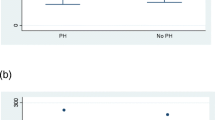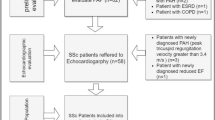Abstract
Pulmonary arterial hypertension (PAH) is the major complication of systemic sclerosis (SSc) and the main cause of morbi-mortality. It is important to find predictors for this vascular problem. The objective of this study was to determine the serum levels of different biomarkers in patients with SSc and secondary PAH and to compare them with those of healthy control subjects to define their potential role as predictors of PAH. Cross-section study in which 20 patients with SSc were included. PAH was diagnosed by echocardiogram. The optical densities of endoglin (Eng), endothelin-1 (ET-1), platelet-derived growth factor (PDGF), tumoral necrosis factor alpha (TNF-α), Transforming growth factor beta 2 (TGF-β2) and Interleukin 8 (IL-8) were measured in 20 patients with SSc and 20 healthy controls matched by sex. The differences found between the group of patients with PAH and the control group were (mean or median and range): ET-1 (0.20; 0.10–0.35 vs. 0.16; 0.10–0.24; P = 0.0276), IL-8 (195.7; 45.5–504 vs. 118.9; 23–299.5; P = 0.0364), TNF-α (0.70; 0.50–0.96 vs. 0.48; 0.38–0.65; P = 1 × 10−8) and Eng (0.95; 0.57–1.72 vs. 0.75; 0.57–0.89; P = 0.0028). A correlation was found between the progression of the disease and the development of Raynaud’s phenomenon (Rho: 0.67 and P = 0.0011), ET-1 and Eng (Rho: 0.53 and P = 0.0196), and between IL-8 and Eng (Rho: 0.68 and P = 0.0019). In conclusions, the elevation of the serum levels of Eng and ET-1 could represent a useful tool as PAH biomarkers. Nevertheless, the diagnostic value of these markers needs to be determined by prospective studies.




Similar content being viewed by others
References
LeRoy EC, Black C, Fleischmajer R et al (1988) Scleroderma (systemic sclerosis): classification, subsets and pathogenesis. J Rheumatol 15:202–205
Kahaleh MB (1992) The role of vascular endothelium in fibroblast activation and tissue fibrosis, particularly in scleroderma (systemic sclerosis) and pachydermoperiostosis (primary hypertrophic osteoarthropathy). Clin Exp Rheumatol 10(Suppl 7):51–56
Block JASW (2001) Raynaud’s phenomenon. Lancet 23:20–28
Herrick AL (2000) Vascular function in systemic sclerosis. Curr Opin Rheumatol 12:527–533. doi:10.1097/00002281-200011000-00009
Denton CP, Black CM (2003) Pulmonary hypertension in systemic sclerosis. Rheum Dis Clin North Am 29:335–349. doi:10.1016/S0889-857X(03)00024-3
Coghlan JG, Mukerjee D (2001) The heart and pulmonary vasculature in scleroderma: clinical features and pathobiology. Curr Opin Rheumatol 13:495–499. doi:10.1097/00002281-200111000-00008
Wigley FMLJ, Mayes M, McLain D et al (2005) The prevalence of undiagnosed pulmonary arterial hypertension in subjects with connective tissue disease at the secondary health care level of community-based rheumatologists. Arthritis Rheum 52:2125–2132. doi:10.1002/art.21131
British Cardiac Society Guidelines (2001) Recommendations on the management of pulmonary hypertension in clinical practice. Heart 86(Suppl):I1–I13
Vancheeswaran R, Magoulas T, Efrat G et al (1994) Circulating endothelin-1 levels in systemic sclerosis subsets-a marker of fibrosis or vascular dysfunction? J Rheumatol 21:1838–1844
Cambrey AD, Harrison NK, Dawes KE et al (1994) Increased levels of endothelin-1 in bronchoalveolar lavage fluid from patients with systemic sclerosis contribute to fibroblast mitogenic activity in vitro. Am J Respir Cell Mol Biol 11:439–445
Morelli S, Ferri C, Di Francesco L et al (1995) Plasma endothelin-1 levels in patients with systemic sclerosis: influence of pulmonary or systemic arterial hypertension. Ann Rheum Dis 54:730–734
Morelli S, Ferri C, Polettini E et al (1995) Plasma endothelin-1 levels, pulmonary hypertension, and lung fibrosis in patients with systemic sclerosis. Am J Med 99:255–260. doi:10.1016/S0002-9343(99)80157-0
Yamane K, Miyauchi T, Suzuki N et al (1992) Significance of plasma endothelin-1 levels in patients with systemic sclerosis. J Rheumatol 19:1566–1571
Kahaleh MB (1991) Endothelin, an endothelial-dependent vasoconstrictor in scleroderma. Enhanced production and profibrotic action. Arthritis Rheum 34:978–983. doi:10.1002/art.1780340807
Venkatesan NRP, Ludwing MS (2002) Proteoglycan expression in bleomycin lung fibroblasts: role of transforming growth factor-beta (1) and interferon-gamma. Am J Physiol Lung Cell Mol Physiol 283:L806–L814
Atamas SP, White B (2003) The role of chemokines in the pathogenesis of scleroderma. Curr Opin Rheumatol 15:772–777. doi:10.1097/00002281-200311000-00015
Varga J (2002) Scleroderma and Smads: dysfunctional Smad family dynamics culminating in fibrosis. Arthritis Rheum 46:1703–1713. doi:10.1002/art.10413
Tamby MC, Chanseaud Y, Guillevin L et al (2003) New insights into the pathogenesis of systemic sclerosis. Autoimmun Rev 2:152–157. doi:10.1016/S1568-9972(03)00004-1
Verrecchia F, Mauviel A, Farge D (2006) Transforming growth factor-beta signaling through the Smad proteins: role in systemic sclerosis. Autoimmun Rev 5:563–569. doi:10.1016/j.autrev.2006.06.001
Denton CP, Abraham DJ (2001) Transforming growth factor-beta and connective tissue growth factor: key cytokines in scleroderma pathogenesis. Curr Opin Rheumatol 13:505–511. doi:10.1097/00002281-200111000-00010
Sambo P, Baroni SS, Luchetti M et al (2001) Oxidative stress in scleroderma: maintenance of scleroderma fibroblast phenotype by the constitutive up-regulation of reactive oxygen species generation through the NADPH oxidase complex pathway. Arthritis Rheum 44:2653–2664. doi:10.1002/1529-0131(200111)44:11<;2653::AID-ART445>;3.0.CO;2-1
Denton CP, Black CM, Abraham DJ (2006) Mechanisms and consequences of fibrosis in systemic sclerosis. Nat Clin Pract Rheumatol 2:134–144. doi:10.1038/ncprheum0115
Varga J, Abraham D (2007) Systemic sclerosis: a prototypic multisystem fibrotic disorder. J Clin Invest 117:557–567. doi:10.1172/JCI31139
Bolster MB, Ludwicka A, Sutherland SE et al (1997) Cytokine concentrations in bronchoalveolar lavage fluid of patients with systemic sclerosis. Arthritis Rheum 40:743–751. doi:10.1002/art.1780400422
Kadono T, Kikuchi K, Ihn H et al (1998) Increased production of interleukin 6 and interleukin 8 in scleroderma fibroblasts. J Rheumatol 25:296–301
Koch AE, Kronfeld-Harrington LB, Szekanecz Z et al (1993) In situ expression of cytokines and cellular adhesion molecules in the skin of patients with systemic sclerosis. Their role in early and late disease. Pathobiology 61:239–246
Strieter RMBJ, Keane MP (2002) CXC chemokines in angiogenesis related to pulmonary fibrosis. Chest 122:298S–301S. doi:10.1378/chest.122.6_suppl.298S
Burrows FJDE, Tazzari PL, Amlot P et al (1995) Up-regulation of endoglin on vascular endothelial cells in human solid tumors: implications for diagnosis and therapy. Clin Cancer Res 1:1623–1634
Torsney ECR, Parums D, Collis M et al (2002) Inducible expression of human endoglin during inflammation and wound healing in vivo. Inflamm Res 51:464–470. doi:10.1007/PL00012413
Wong SHHL, Chevalier S, Philip A (2000) Endoglin expression on human microvascular endothelial cells association with betaglycan and formation of higher order complexes with TGF-beta signalling receptors. Eur J Biochem 267:5550–5560. doi:10.1046/j.1432-1327.2000.01621.x
Walker JG, Stirling J, Beroukas D et al (2005) Histopathological and ultrastructural features of dermal telangiectasias in systemic sclerosis. Pathology 37:220–225. doi:10.1080/00313020500033262
Leask A, Abraham DJ, Finlay DR et al (2002) Dysregulation of transforming growth factor beta signaling in scleroderma: overexpression of endoglin in cutaneous scleroderma fibroblasts. Arthritis Rheum 46:1857–1865. doi:10.1002/art.10333
Preliminary criteria for the classification of systemic sclerosis (scleroderma). Subcommittee for scleroderma criteria of the American Rheumatism Association Diagnostic, Therapeutic Criteria Committee (1980) Arthritis and Rheum 23:581–590
Battle RW, Davitt MA, Cooper SM et al (1996) Prevalence of pulmonary hypertension in limited and diffuse scleroderma. Chest 110:1515–1519. doi:10.1378/chest.110.6.1515
Mukerjee D, George St D, Coleiro B et al (2003) Prevalence and outcome in systemic sclerosis associated pulmonary arterial hypertension: application of a registry approach. Ann Rheum Dis 62:1088–1093. doi:10.1136/ard.62.11.1088
Clements PJ, Lachenbruch PA, Seibold JR et al (1993) Skin thickness score in systemic sclerosis: an assessment of interobserver variability in 3 independent studies. J Rheumatol 20:1892–1896
Kuryliszyn-Moskal A, Klimiuk PA, Sierakowski S (2005) Soluble adhesion molecules (sVCAM-1, sE-selectin), vascular endothelial growth factor (VEGF) and endothelin-1 in patients with systemic sclerosis: relationship to organ systemic involvement. Clin Rheumatol 24:111–116. doi:10.1007/s10067-004-0987-3
Southcott AM, Jones KP, Li D et al (1995) Interleukin-8. Differential expression in lone fibrosing alveolitis and systemic sclerosis. Am J Respir Crit Care Med 151:1604–1612
Crestani B, Seta N, Palazzo E et al (1994) Interleukin-8 and neutrophils in systemic sclerosis with lung involvement. Am J Respir Crit Care Med 150:1363–1367
Furuse S, Fujii H, Kaburagi Y et al (2003) Serum concentrations of the CXC chemokines interleukin 8 and growth-regulated oncogene-alpha are elevated in patients with systemic sclerosis. J Rheumatol 30:1524–1528
Hasegawa M, Fujimoto M, Kikuchi K et al (1997) Elevated serum tumor necrosis factor-alpha levels in patients with systemic sclerosis: association with pulmonary fibrosis. J Rheumatol 24:663–665
Majewski S, Wojas-Pelc A, Malejczyk M et al (1999) Serum levels of soluble TNF alpha receptor type I and the severity of systemic sclerosis. Acta Derm Venereol 79:207–210. doi:10.1080/000155599750010986
Meloni F, Caporali R, Marone Bianco A et al (2004) BAL cytokine profile in different interstitial lung diseases: a focus on systemic sclerosis. Sarcoidosis Vasc Diffuse Lung Dis 21:111–118
Scala E, Pallotta S, Frezzolini A et al (2004) Cytokine and chemokine levels in systemic sclerosis: relationship with cutaneous and internal organ involvement. Clin Exp Immunol 138:516–540. doi:10.1111/j.1365-2249.2004.02642.x
Hussein MR, Hassan HI, Hofny ER et al (2005) Alterations of mononuclear inflammatory cells, CD4/CD8 + T cells, interleukin 1beta, and tumour necrosis factor alpha in the bronchoalveolar lavage fluid, peripheral blood, and skin of patients with systemic sclerosis. J Clin Pathol 58:178–184. doi:10.1136/jcp.2004.019224
Fujimoto M, Hasegawa M, Hamaguchi Y et al (2006) A clue for telangiectasis in systemic sclerosis: elevated serum soluble endoglin levels in patients with the limited cutaneous form of the disease. Dermatology 213:88–92. doi:10.1159/000093846
Snowden N, Coupes B, Herrick A et al (1994) Plasma TGF beta in systemic sclerosis: a cross-sectional study. Ann Rheum Dis 53:763–767
Dziadzio M, Smith RE, Abraham DJ et al (2005) Circulating levels of active transforming growth factor beta1 are reduced in diffuse cutaneous systemic sclerosis and correlate inversely with the modified Rodnan skin score. Rheumatology (Oxford) 44:1518–1524. doi:10.1093/rheumatology/kei088
Ludwicka A, Ohba T, Trojanowska M et al (1995) Elevated levels of platelet derived growth factor and transforming growth factor-beta 1 in bronchoalveolar lavage fluid from patients with scleroderma. J Rheumatol 22:1876–1883
Kikuchi K, Kadono T, Ihn H et al (1995) Growth regulation in scleroderma fibroblasts: increased response to transforming growth factor-beta 1. J Invest Dermatol 105:128–132. doi:10.1111/1523-1747.ep12313452
Acknowledgments
To our patients and their families. The financial support for the present study was provided by The Vicerrectoria de Investigación and Division de Investigación de Bogotá, Universidad Nacional de Colombia. None of the authors have any financial interest that has influenced the results.
Author information
Authors and Affiliations
Corresponding authors
Additional information
Drs. P. Coral-Alvarado and G. Quintana contributed equally to this work and both should be considered as first authors.
Rights and permissions
About this article
Cite this article
Coral-Alvarado, P., Quintana, G., Garces, M.F. et al. Potential biomarkers for detecting pulmonary arterial hypertension in patients with systemic sclerosis. Rheumatol Int 29, 1017–1024 (2009). https://doi.org/10.1007/s00296-008-0829-8
Received:
Accepted:
Published:
Issue Date:
DOI: https://doi.org/10.1007/s00296-008-0829-8




